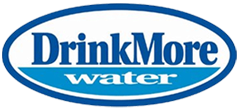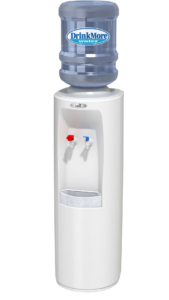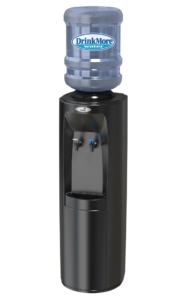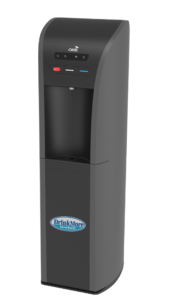Bisphenol A is arguably one of the most controversial compounds on earth. It’s been studied, researched, and tested by hundreds of scientists in hundreds of studies. Many of these studies indicate that it is harmless in the quantities tested, while others conclude that it is a serious endocrine disrupter.
As background, bisphenol A, or BPA, is a chemical compound that goes into many different products, some food-related and some not. It has been widely used for many years and continues to be used today. One of its primary uses is to make a type of plastic called polycarbonate (also known as “Lexan”). This material is used extensively as a liner for both steel and aluminum cans—including everything from soup and tuna fish cans to beer and soda cans. Every one of these cans needs some type of coating to prevent rusting on the inside to avoid the food or beverage acquiring a metallic taste.
In the bottled water business, polycarbonate has been the traditional plastic of choice for 5 gallon bottles since the industry began. But because of the BPA concern, many consumers wanted other choices for their bottled water containers. DrinkMore Water has been a pioneer in the industry in this area. More than 10 years ago, we made the decision to eliminate all polycarbonate jugs from our inventory by switching all of our bottles to PET plastic, then additionally offering glass 3 and 5 gallon bottles to our purity-discerning customers.
BPA continues to be a significant issue for the food industry. It’s difficult to say whether it’s 100% safe or not – but at DrinkMore, we’re not taking any chances. We’ve said NO to BPA in our containers. Ultimately, the decision to switch from polycarbonate bottles to PET and glass bottles required an investment of well more than $1 million—but that was a small price to pay to ensure the purity of our water for our customers. It was the best way to offer our customers the peace of mind that they would never have any BPA in any of their DrinkMore Water products. We are proud to offer bottled water that you can consume without any concern for BPA or for your or your family’s health or safety.
Here are the blog posts – but, please note that I can’t guarantee that all of the links are still working…
Post #1 – April 8, 2008
There have been a number of media stories recently regarding the safety of bottles made out of polycarbonate – which has as one of its ingredients a substance called bisphenol A, or BPA. Several customers have called saying they saw one of these reports on TV or in the newspaper and were inquiring as to what DrinkMore Water had to say about the issue.
First of all, these reports are all reviews of existing studies. None of these reports or panels provides any new research, rather, they are commenting on and analyzing the studies that have been done in the past. The one thing that is perfectly clear to me is that a lot more research has to be done on the issue before definitive conclusions are reached. Polycarbonate has long been approved for usage by the FDA (US Food and Drug Administration) for beverage containers. There are several things at issue here that the scientific community cannot seem to agree upon. For example, there is a question as to whether or not BPA can migrate from the bottle. That leads to other questions – like what test conditions should we use to see if BPA does or does not migrate. So, one camp says let’s pour boiling hot water into the bottle, add harsh cleaning chemicals and see what happens with respect to migration. That would be simulating the worst possible scenario. Another camp might evaluate the migration issue using real world conditions – like washing at a much lower temperature with commonly used washing detergents.
Then there is the question of whether BPA is toxic at all. From my reading, there are no clear cut conclusions. It’s similar to the recent study by the Associated Press (which was also a review of existing literature) that concluded there were pharmaceutical drugs in the tap water of most communities nationwide. Birth control medications, high blood pressure drugs, and anti-depressants were among those identified. So, a big question is “how much is actually in there”? And the next question is “how much is too much”? I saw one analysis that suggested you would have to consume several thousand gallons of water before ever coming close to the dosage in a single birth control pill. So, should you be worried? That is for each person to decide for him/herself.
So, I went to the bottled water industry’s website and here is the statement that I found: http://www.bottledwatermatters.com/
I would encourage you to go and read that article. As far as DrinkMore Water is concerned, we continue to monitor the issue closely. As most of you already know, we carry several alternatives to the polycarbonate 5-gallon bottles. We carry both 3-gallon and 5-gallon glass bottles that are purity defined. Nothing can or will ever migrate from glass. Then we also carry a full line of BPA-Free PET (that’s #1 plastic) bottles including all sizes of single serve – 12 oz, ½ liter, 24 oz, and 1 liter – as well as 5-gallon bottles in PET that do not have any BPA in them whatsoever. They come at a slightly higher cost than the polycarbonate bottles. If you are interested in switching to glass or PET bottles, please give our Customer Service Team a call and they can help you out.
Rest assured that your DrinkMore Water team is on top of this issue and will continue to keep you – our valued customers – informed of all the latest developments.
Post #2 – April 27, 2008
Please forgive me in advance because this is a long entry for a blog. If you truly want to learn more about issues swirling around BPA, then please read it all. I think you’ll find it quite interesting.
Well, I think this week alone, there have been three front page articles in the Washington Post regarding Bisphenol-A (BPA). I thought it might be worthwhile to jot down some additional thoughts for people to consider.
One of the biggest problems fueling the BPA controversy is the idea that the FDA’s guideline for maximum BPA consumption (currently 50 micrograms/kilogram of bodyweight) is too high. Some researchers believe that number is too high (while the FDA and other researchers currently think it’s correct). The media has taken to the story and practically implies that any BPA at all will probably kill you.
So, to put that number – 50 micrograms/kilogram of bodyweight – into context, I think it would be beneficial to compare the FDA’s BPA guidelines to some other chemicals that are found around town. First of all, it is important to realize that BPA is a lot more prevalent in products than perhaps many people think. Did you know that in addition to being found in polycarbonate bottles, BPA is used to line the interior of just about every soup can, every beer can, every soda can, every baby formula can, every canned green beans can, etc. There are a very, very few food manufacturers who use other chemical formulations to line the interior of their cans. Obviously, every can has to be lined with something to keep the food or beverage from coming into direct contact with the metal of the can. Without a lining, the can would begin rusting immediately (if it was steel or tin). Aluminum cans would start leaching aluminum into the food or beverage if not properly lined. So, all cans need to be lined. Eden Foods, for example, claims that their cans are not lined with BPA – but I can’t find out exactly what chemicals they are using to line their cans.
So, BPA is out there in all sorts of places that people don’t normally think of. The media focus has been on bottles made out of polycarbonate. The National Toxicology Program, which recently released its preliminary findings, was primarily focused on the effects of BPA on babies and pregnant women. That focus was based upon research (done on mice) that suggests babies may be less able to process and eliminate BPA than are adults. The focus therefore was on baby bottles. Furthermore, mothers have been told to sterilize their baby bottles in order to kill bacteria. Washing baby bottles with boiling water can exacerbate the migration of BPA from polycarbonate bottles. So, BPA’s effects on infants have come into focus.
So, let’s dig a little deeper. For reference purposes, let’s take a person who weighs 154 lbs (that would be 70 kilograms). The FDA’s guideline of 50 micrograms per kilogram means that a 154 lb person should have a maximum daily BPA intake of not more than 3,500 micrograms of BPA (which is equivalent to 3.5 milligrams). Exactly how much is one microgram? Let’s say you put one microgram of BPA into a liter of water. The concentration of BPA would be one microgram per liter. That is the equivalent to one part per billion. That is a very small amount. It is the equivalent of one second in 32 years!! So 3,500 micrograms is equivalent to about one hour in 32 years.
The real question is how much is too much. Is it 3,500 micrograms? Is it 1,000 micrograms? Is it 100 micrograms? Should it be zero micrograms? I can assure you that I don’t know the answer to that question – nor do any of the scientists who have performed the studies. But, I do know that there are all sorts of chemicals that we consume every single day. Some are a lot more toxic than others. Let’s look at lead (a heavy metal that EVERYONE AGREES IS VERY, VERY TOXIC). EPA regulations say that that maximum amount of lead in tap water should be no more than 15 micrograms per liter (or 15 parts per billion). By the way, the FDA – which regulates bottled water says that maximum number for lead should be 10 micrograms per liter. So when you read that bottled water doesn’t even have to meet EPA levels – you know someone is being dishonest!! FDA bottled water regulations are considerably stricter than EPA regulations for tap water.
Does that mean that if your water has 12 micrograms/liter of lead in it, that it’s ok? In a sense yes, and, in other ways, no. I think if you asked most scientists, they would say that 12 is better than 15, but 2 would be better than 12, and zero would be better than 2. Same analysis goes for such tasty things as arsenic or chromium or cyanide. Did you know that the EPA’s maximum contaminant level for cyanide in tap water is 200 micrograms per liter ( while the FDA’s limit for cyanide in bottled water is 100 micrograms per liter). If you drink 3 liters of tap water in a day, that would mean that you could ingest up to 600 micrograms of cyanide and that would be within the limits of acceptability from a risk standpoint according to the EPA. Seems kinda crazy to me. Arsenic’s maximum is 10 micrograms per liter. These are some very toxic chemicals, yet the maximum is not zero.
The point is that it would be virtually impossible from a public policy standpoint to set all these levels to zero. Further confusing the issue is what exactly is zero? There are 1,000 nanograms in one microgram. If you said the limit for lead was one microgram per liter – that’s still 1,000 nanograms. Is that OK? Why not zero? One nanogram is equivalent to one second in 32,000 years!! When do you say enough is enough? That is truly a public policy issue.
So, let’s go back to BPA. How much is too much? Is the amount of BPA in polycarbonate bottles too much? If I told you that there was 1 microgram of BPA in a 5 gallon water bottle, would you switch to a glass bottle or a PET bottle? Remember the 3,500 micrograms? Remember the 600 micrograms of cyanide that the EPA would say is OK? Is BPA more toxic than cyanide? I kinda doubt that but you can and should reach your own conclusions. How many micrograms of BPA are in that can of soup you opened last night? How about those three beer cans you had last night? Drinking diet cola? Yep. Heck, just like with pharmaceuticals in tap water – could there be BPA in tap water? I believe the answer is yes – scientists have found very small amounts in tap water – probably less than 1 microgram per liter. But, what if it was 400 nanograms? Would that be OK?
In a sense, the current controversy surrounding BPA, makes that chemical out to be worse than cyanide or lead or arsenic or any one of a number of extremely toxic chemicals. My guess is that the FDA will review all of the available studies on BPA and determine that it is safe at a particular level. Will the “safe” level remain at 50 micrograms per kg of bodyweight? I don’t know. Maybe they set the new level at 40 micrograms or 25 micrograms or even 10 micrograms per kilogram. If they do that, then polycarbonate water bottles will be deemed safe. If they set a level for bottled water and tap water, the bottles will be deemed safe. Will the controversy go away? I don’t know, but probably not. Think back to the cyanide and arsenic examples. I don’t read anything about the toxicity of cyanide or arsenic in the morning paper – but it’s still very much allowable in food and water.
The bottom line is that every person and every family has to assess the risks and make decisions. I know one thing for certain. We use reverse osmosis technology to remove virtually 99.5% of ALL contaminants from the water. There’s no cyanide, arsenic or lead in our water. That is a good thing. I don’t want to consume more than my fair share of chemicals any more than you do. As a company, DrinkMore Water gives you options. We have BPA-free glass bottles. We have BPA-free plastic (PET #1) bottles. We have FDA-approved polycarbonate bottles. It’s your choice. I wish people would think the same way about the water they drink and the food they eat – and all the chemicals that can be found inside food and water – as they do about BPA. Because if they did, they would only drink DrinkMore Water.
Oh, and by the way, I bring home my DrinkMore Water in polycarbonate bottles. I’ve done so for 15 years, I have three kids, and I have my choice of whatever I want – glass, BPA-free plastic, or polycarbonate.
Told you it was interesting!
If you are interested in yet another perspective, I thought this article was more balanced than most. It just came out this weekend. Check it out:
Post #3 – April 29, 2008
This is just in from the newswire.The FDA comes out with a statement about BPA.PLEASE take a moment to check out the link below.My goal is to keep you informed about all of the recent developments regarding BPA.
http://www.fda.gov/oc/opacom/hottopics/bpa.html
Post #4 – August 21, 2008
As promised, I want to keep you all updated on the latest news about BPA (I think everyone who’s been reading my blog knows by now what BPA is!) and the controversy it has driven worldwide.
In May’s Harvard Health Letter, Harvard’s Dr. Claire McCarthy advised the public to be cautious of the use of plastics, especially when dealing with infants and children, and to minimize exposure to BPA as much as possible because the health risks were unknown at the time. Dr. Elizabeth M. Whelan, President of the American Council on Science and Health responded to this public warning, maintaining “that the use of plastic bottles and other plastic products pose no known hazard to human health.”
In light of all the public opinions by scientists and medical experts, there finally seems to be some light at the end of the tunnel in the ongoing debate on BPA safety. On July 24, the The European Food Safety Authority (EFSA) concluded that “the human body rapidly metabolizes and eliminates Bisphenol A (BPA) and thus the substance presents no risk to adults, children or infants.”
More recently, In its draft assessment made available to the public on August 14, 2008, the US Food and Drug Administration (FDA) “concluded that an adequate margin of safety exists for BPA at current levels of exposure from food contact uses.” The report further states that BPA products are safe for both infants and adults.
In response to recent reports by outside organizations, namely the National Toxicology Program (NTP) and Environmental Canada (EC), the FDA formed a Task Force to evaluate the safety of all BPA-containing FDA-regulated products. Currently, the Task Force has evaluated the claims outlined in the risk assessments released by the NTP and they have made recommendations for further research in the draft assessment. FDA Commissioner,Andrew C. von Eschenbach, M.D, said, “Thus far, the science FDA has reviewed does not justify recommending that anyone discontinue using these products. But we continue to investigate new research regarding the safety of BPA.”
In September, the FDA will hold a meeting open to the public to discuss the draft assessment of the safety of BPA. Outside experts, as a subcommittee of the Science Board, are asked to review the work of the FDA and are to present data, information, or views, orally or in writing, on issues pending before the committee.
I’m on it!!
Post #5 – September 8, 2008
The latest BPA news comes for a Yale studyexamining the effects of BPA against monkeys to more closely simulate the effects of the chemical on humans as opposed to previous studies using rodents. The study revealed a connection between BPA and problems with brain function and mood disorders in the monkeys – marking the first time the chemical has been connected to health problems in primates.
Yale’s study differed from its predecessors because its “goal was to more closely mimic the slow and continuous conditions under which humans would normally be exposed to BPA,” said study author Csaba Leranth, M.D., professor in the Department of Obstetrics, Gynecology & Reproductive Sciences and in Neurobiology at Yale. She claims, “As a result, this study is more indicative than past research of how BPA may actually affect humans.”
The US Food and Drug Administration (FDA) still holds that it is, “not recommending that anyone discontinue using products that contain BPA” while it continues its risk assessment process. The concern for baby bottles is that adding hot liquids to a products containing BPA, such as a plastic baby bottle, could cause the substance to leach from the product and be consumed by infants.
So, until the FDA holds its meeting on BPA on September 15, there will not likely be an official statement on any official US news, but if BPA concerns you, remember there are alternatives like using glass bottles. DrinkMore Water is also the only company (that we know of at least!!) that carries BPA-free #1 5-gallon plastic bottles. So, if you’re concerned about BPA – please give us a call!!



